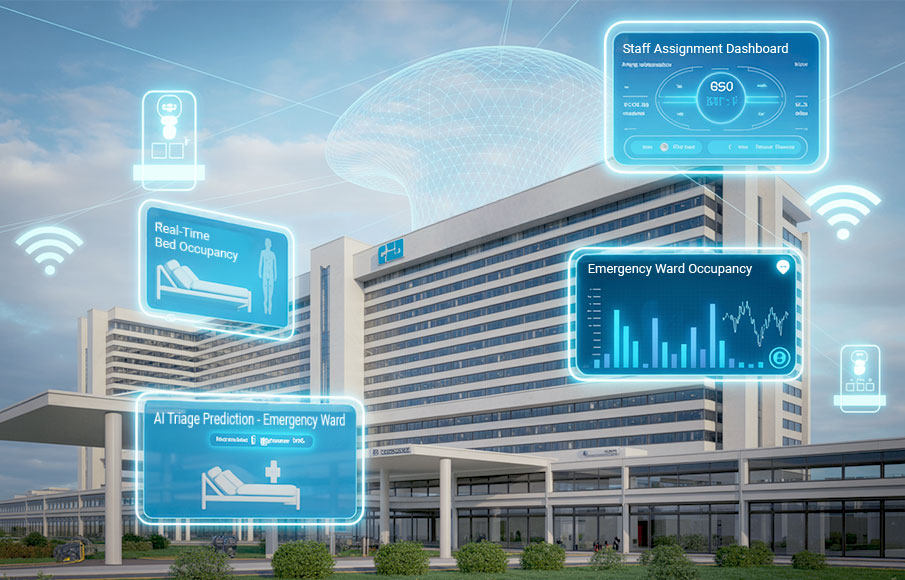What is MPLS and How Does it Work? (Updated 2025)
- 10 November 2024

MultiProtocol Label Switching (MPLS) has been around for over two decades now and has been helping companies boost internet activities since 1997.
In this article, SPTel covers everything you need to know about MultiProtocol Label Switching. Our simplified guide will share a little more on how MPLS can be enhanced with a solution like SD-WAN, to help you understand how you can best leverage MPLS in your connectivity strategy.
What is MPLS (Multiprotocol Label Switching)?
MLPS is a scalable and protocol-independent technique that helps to boost the speed of network traffic. It is particularly useful for enterprise networks that require reliable and secure point-to-point connectivity between multiple locations.
MPLS does all this through a simple process of directing data through a path via labels. Unlike traditional internet connectivity / internet protocol (IP), where data has to move from one internet node to another due to long network addresses.
With the traditional internet protocol, when the data packet lands on a router, the router has to decide what next move the IP packet should make and its next stop on the network. This decision is made based on the routing tables, making the process somewhat slow.
With MPLS, data doesn’t require all the many complex lookups in a routing table. MPLS already sets a predetermined destination IP address for all the data packets and sends it along that path by assigning a label to each one of them.
When the data packet passes through the MPLS network, the label is stripped off or replaced. This process speeds up the data transfer by a margin because it reduces the router functionality to switch functionality.
Information is distributed in a way that every switch along the path knows everything it’s supposed to do by looking at the MPLS table.
MPLS has brought a major boost to companies worldwide by improving the speed and effectiveness of their networks. The sector is valued at $21.07 billion in 2025, and is projected to have a 6.78% CAGR from 2025 to 2033. This expansion is a sign of healthy growth within the IT sector, making it a key tool for businesses looking to expand their operations far into the future.
Are you looking for an International MPLS provider in Singapore? SPTel offers an International MPLS solution which covers over 3,000 cities worldwide that will enable you to expand your business globally.

How does an MPLS Network Function?
Knowing the level of ease and speed that the MPLS network offers to businesses, it is important to understand fully how the system works. Before that, it is pertinent to know that MPLS supports the following applications:
- Traffic Engineering (TE)
- Quality of Service (QoS)
- Virtual Private Networks (VPN)
- Any Transport over MPLS (AToM)
When a packet enters the MPLS network, it is assigned to a forwarding CoS (Class of Service), also referred to as a forwarding equivalence class (FEC), which is indicated by appending a label—not the IP header—to the packet. The CoS usually indicates the type of traffic the label is carrying through the MPLS network.
What MPLS does is boost the information/data transfer speeds by simply converting routed networks into something similar to switched networks. This function is not found in the traditional IP-routed network.
MPLS connections are established through the help of label-switched paths (LSPs), which will establish paths for specific source-destination pairs.
Every packet that goes through the MPLS networks is named into the service provider’s network by the LER (Label Edge Router). The Label Switching Routers (LSRs) will send packets with the help of the MPLS without looking towards the IP header, thereby eliminating the hop-by-hop sequence.
Every router in the LSP performs the functions including:
1. Ingress node
Only one ingress router is assigned to every L-S-P. The ingress router is the one at the forefront of the LSP that sums up all the IP packets with a MultiProtocol Label Switching Layer 2 frame. The router then forwards it to the next router in the path.
2. Egress node
The egress router is different and must be separate from the ingress router. This is the one at the end of the label switched path (LSP) that converts the MPLS coverage from an MPLS packet to an IP packet. However, unlike the ingress router, this one forwards the packet to its final destination via the normal IP routing.
3. Transit node
As the name implies, the transit router is the one that collects information from the ingress and transfers it to the egress. Sometimes, there are no transit routers in the LSP, and other times, there can be up to 253 of them. They receive and forward MPLS packets throughout the MPLS paths.
MultiProtocol Label Switching makes real-time applications seamless, straightforward, and rewarding. This is because, unlike MPLS, other routing protocols cannot separate traffic based on performance. We will go into some detail about the benefits later in the article.

Where does MPLS (MultiProtocol Label Switching) fall within an OSI Hierarchy: Layer 2 or Layer 3?
Many organisations have tried to classify MPLS into either layer 2 (data link layer) or layer 3 (network layer). However, MPLS does not fit perfectly into any of these.
MPLS falls in-between both layers to become a layer 2.5 networking protocol. This is because layer 3 uses IP protocols for routing and internet-wide addressing while layer 2 carries IP packets over point to point wide area networks (WANs) or LANs.
MultiProtocol Label Switching can generally be used to create forwarding tables for any kind of primary protocol. When traffic is sent into the MPLS networks by an end-user, an ingress node adds an MPLS label. Within the MPLS label, there are four sub-parts at least and they are:
1. The Label value
The label is what contains the information while the routers decide the next location for the packet.
2. Traffic class field/experimental bits
The traffic class field or experimental bits are what determine the priority of the labelled packet. It serves as the quality of service (QoS).
3. Bottom of stack
With all that has been described in how MultiProtocol Label Switching works, we can see that the journey looks more like a relay race. The bottom of stack is what informs the MPLS routers that they’re the last ones in the journey.
4. Time-to-live (TTL) field
The TTL field determines the lifespan of the data, or how many hops it can make before it becomes useless.
Labels can also be stacked. The top label controls packet delivery; when it reaches its destination, that label is “popped,” and the label underneath takes over for direction.

Advantages and disadvantages of MultiProtocol Label Switching
There are several advantages and a few disadvantages to using MPLS networks. We will look at an overview of both sides to give you an idea about the service.
Advantages
- Cost-effectiveness: MPLS is a Layer 2.5 technology, which means that network resources can be easily shared among organisations or offices. It also allows routing of customers’ data on a virtual private network.
- Bandwidth: multiple traffic can be held on every MPLS label, making it optimally utilised.
- It offers matchless scalability: compared to other popular options, the MPLS connection is more scalable. By combining a combination of physical circuits with the cost-effectiveness of IP routing, our MultiProtocol Label Switching services at SPTel provide you with matchless scalability at reduced costs.
- It is highly efficient (high-quality connections): MPLS is known for providing high-quality, SLA-backed connections. Because it uses predetermined paths and can prioritise traffic, MPLS networks have near-zero packet loss and low jitter for critical applications. MPLS allows for much higher quality connections than an SD-WAN. To further optimise this, it can be merged with VoIP.
- Completely reliable: MPLS uses labels for packet forwarding, assuring organisations of high-performance at any point in time. Network traffic can also be assigned based on priority. SPTel’s MPLS services offer you committed network performance by prioritising traffic based on your preferred class of services (CoS).
- Unified Management: With MPLS delivered by SPTel, your wide-area network can be easier to monitor and manage. Service providers such as SPTel can handle the complexity of routing, traffic engineering, and maintenance. Benefits for the customer include a committed level of performance without having to micromanage every router. Additionally, because MPLS networks are centrally managed, troubleshooting tends to be faster, and this can simplify IT operations for organisations without large in-house networking teams.
Tap on these benefits with SPTel’s International MPLS solution. We offer 4 Classes of Service to optimise ERP systems, CRM, SaaS, and many more applications in a private network.
Disadvantages
- It may be difficult to control personally.
- Security issues: security is completely handed to the user. This means that you may have to work hand in hand with the service provider to provide extra security for your network.
- It can be difficult to deploy: if a company has offices in different locations, installation and deployment can sometimes take months. However, a site with simple MPLS links can be much easier. But not to worry, SPTel dwells in over 200 cities around the world, helping you scale all WAN connectivity with relative ease.

SD-WAN vs MPLS: How MPLS can be optimised with SD-WAN
MPLS offers more consistent connectivity since the information is moved in labels, deciding the next hop in the sequence by predetermination on the MPLS table. This makes for increased network performance. Simply put, MPLS is a high-quality networking technology that makes networking seamless and fast. However, this solution does come at a cost and organisations may find their infrastructure budgets stretched if this solution is used for all connectivity needs. It also needs to be configured manually which may lead to increased complexity when you have multiple branches.
This is where Software-defined Wide Area Network (SD-WAN) can enhance your MPLS solution and make your network more manageable and cost-effective.
SDWAN is a virtual WAN architecture that allows you to securely connect users to applications on any combination of transport services – such as MPLS, LTE and broadband internet services.
An SD-WAN is decoupled from physical links and its virtual overlay allows it to use a centralised control function to securely and intelligently route traffic across your network. Unlike MPLS that has to be configured physically/manually at every portal or branch, SD-WAN allows you to manage and control your network from a central point, giving you more control with an SD-WAN box at each branch.
Crucially, SD-WAN can complement an existing MPLS network by providing failover and bandwidth augmentation. For instance, if the MPLS link at a branch is maxed out or experiences an outage, the SD-WAN can instantly shift traffic to a secondary internet link (such as 5G, IPVPN, or other Internet Broadband Solutions) to keep things running.
SD-WAN also allows you to split your network, making it easier to set up and manage hybrid networks. It also allows network agility, using the best link to the right resource based on business metrics and policies so that you can prioritise critical functions to run on an MPLS while noncritical functions can be run using a more affordable Internet line. This approach helps you improve your total cost of ownership.
Bottom line: MPLS Solution by SPTel
An MPLS solution is great for mission critical use cases but it is not feasible to run your entire network infrastructure on MPLS alone. With SD-WAN you can improve your control and flexibility down to even granular traffic control. You can even integrate cyber security solutions to your network and manage and maintain security access in a more holistic manner.
The same SD-WAN deployment can help you manage multiple connection strategies beyond MPLS as well, including public internet, IPSec, SSL and more. Making it an invaluable addition to your network management strategy.
Our MPLS solution also ensures regional connectivity that links to public cloud services like AWS, Google, and Azure without the expense and hassle of self-set-up.
Speak to us today to find out more about how SPTel’s MPLS solutions paired with SDWAN can help you drive greater business efficiency.












